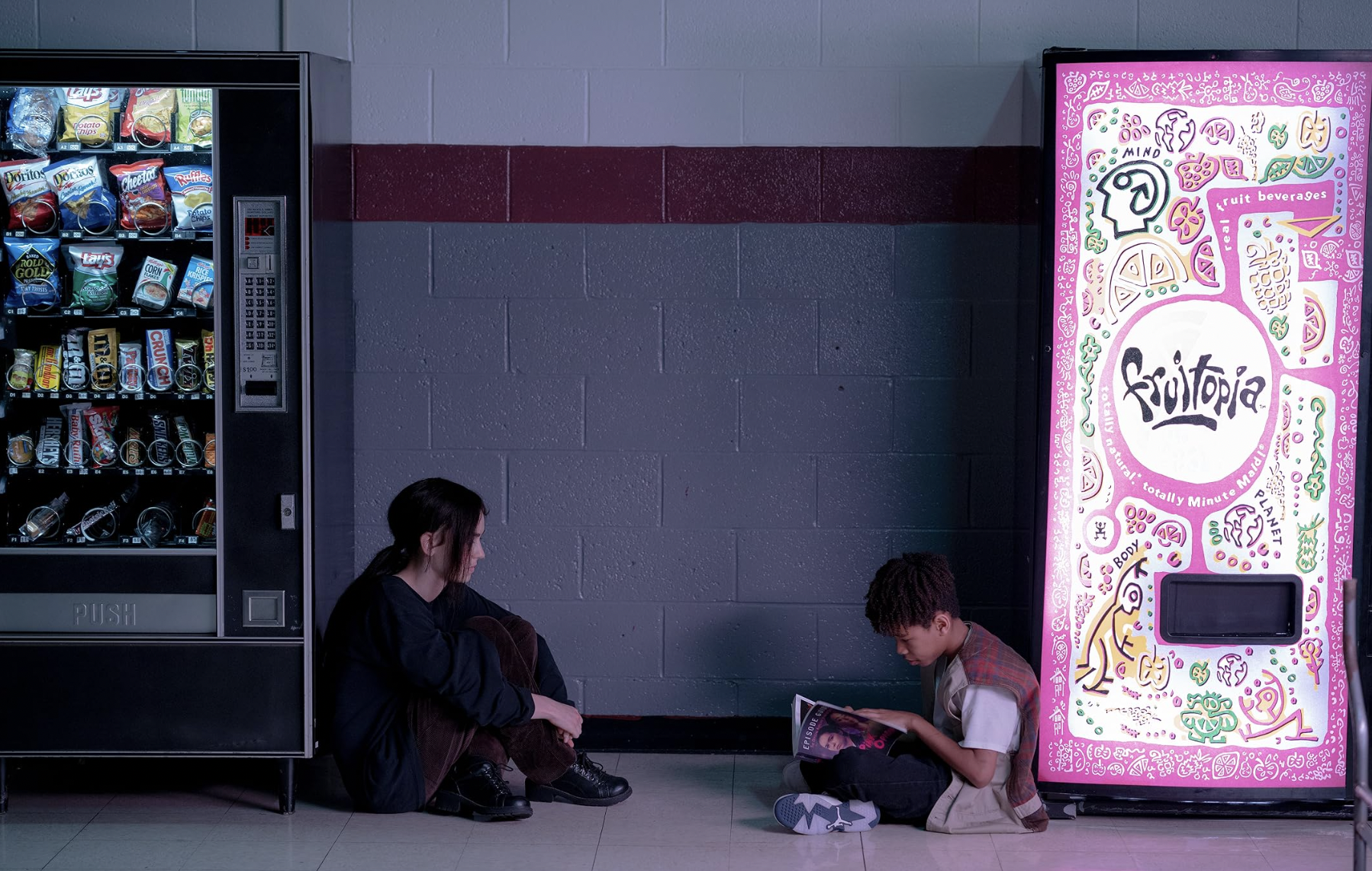We all want to “feel seen” nowadays, or at least we’re supposed to, even though the film canon and the thrift-store VHS racks alike are well-stocked with warnings of what happens when the camera catches you in its sights. Even if the experience is as slight as relating momentarily over some minor quirk you happen to share with thousands, the therapeutic value of the media-mirrored self is accepted as a given. But what if all you ever wanted was to hide—if you’re in this picture and you don’t like it?
Like their low-budget, high-concept 2021 debut feature, We’re All Going to the World’s Fair, Jane Schoenbrun’s I Saw the TV Glow reconfigures the trans coming-out narrative as a horror story, as open to peril as to promise. Two teens growing up in the ’90s bond over a show on “the Young Adult network” modeled after Buffy the Vampire Slayer (right down to the credits font); as the edges of supposed fiction and supposed reality blur, the knowledge they gain about their potential selves brings suffering, whether they accept or retreat from that insight. And while plenty of viewers (some trans, but not exclusively—adolescence can be a time of dysmorphia and identity flux even for the cis and the straight) have already seen themselves in this film, and felt seen, what’s being reflected back at them is not always reassuring.
Owen (played at first by Ian Foreman) is a dreamy if not especially imaginative seventh grader kept on a short leash by his parents—his 10:15 p.m. bedtime is strictly enforced, even on weekends. (Even, we’ll learn, after he enters high school.) For Owen, the mildest rite of suburban rebellion, like lying to your parents about sleeping over at a friend’s house, feels like a major transgression that he wouldn’t dare commit if not for Maddy (Brigette Lundy-Paine).
A ninth grader in baggy black who radiates an almost visible shield of don’t-talk-to-me-ness, Maddy’s sitting on a gym floor, back to the wall, buried in a paperback episode guide for a show called The Pink Opaque when Owen first spots her. “That looks like the best book ever,” he says, though he knows almost nothing about the series. He then asks Maddy possibly the worst question he could: “Isn’t that a kids’ show?” She responds to this and each of his questions with an age-appropriate scoff, and then scoffs again when he apologizes for getting so much wrong. And yet, maybe because she already recognizes, as she eventually tells him, “You’re like me, you’re special,” she invites the kid to her house, to indoctrinate him into the show’s mythology.
On The Pink Opaque, two girls (Helena Howard as the more hesitant Isabel—"a bit of a drip,” per Maddy—and Lindsey Jordan of the very '90s-nostalgic indie band Snail Mail as the butch Tara) share a psychic connection. Each week they battle murderous clowns and humanoid ice cream cones and an evil foe called Mr. Melancholy who glares down at them from the moon. There’s a local teen club like Buffy’s The Bronze that’s equally reminiscent of The Roadhouse from Twin Peaks, another touchstone, and Phoebe Bridgers sits in on one of the performances we watch. As Owen’s grouchy dad asks, damningly, “Isn’t that a show for girls?” I believe those are the only words we ever hear him articulate.
Fast forward to ninth grade, and in the intervening years Maddy has been supplying Owen (now played by Justice Smith, though his voice seems unchanged, like he’s always on the verge of tears) with videos of each week’s The Pink Opaque. They speak to each other in a Lynchian blend of heightened mood and flattened affect, a mode of delivery that Lundy-Paine particularly wrenches the most from in an extended late-film monologue. We sense barely any affection between them—just intensity and some sort of undefined affinity.
There’s certainly nothing sexual about their friendship. When Maddy asks Owen if he likes boys or girls, he stammers, as though discovering this for the first time, “I think I like TV shows.” Then he grows unexpectedly eloquent on the subject: “When I think about that stuff, it feels like someone took a shovel and dug out all of my insides, and I know there’s nothing in there, but I’m still too nervous to open myself up and check.”
And nothing will make him look into that void. Maddie plans to split town; Owen hides so he won’t have to go with her and settles into a pointless job as a movie usher, where he’s unable to even look his boss in the eye. Then, after disappearing mysteriously for several years, his friend returns, no longer answering to “Maddy,” with a disturbing, possibly liberating discovery that we can tell almost immediately that Owen will reject.
Throughout, Schoenbrun’s style builds on the familiar elements of the A24 aesthetic (dread emanating from an unknown source, an avoidance of horror cliché so mannered it becomes its own cliché, the phosphorescence of bisexual pastels everywhere a-glimmer) while expanding them into something both more idiosyncratically personal and generally resonant. The TV is far from all that glows here—so do children’s chalk drawings on the streets ("There Is Still Time,” these advise Owen late in the film), the matching tattoos on The Pink Opaque heroines’ necks that resemble bespectacled Pac-Man ghosts, the produce aisle in the supermarket where Maddy and Owen reunite in 2006 (with three giant flags suspended behind them, underlining that we’ve entered the Bush years). Even a Fruitopia machine in the high school gym radiates like a monolith from another world.
When she returns to town, Maddy tells Owen that every time she thinks back to watching The Pink Opaque “it’s like the memories got shook up in my head like a snow globe.” She could just as well be describing I Saw the TV Glow itself, a jarring reshuffling of ’90s kid culture, recollected in something less than tranquility. There’s a sinister bent that’s a welcome corrective to the sentimental nostalgia the media products and other child-friendly consumer goods of that “simpler time” generally evoke.
It’s there in the casting: Amber Benson (she played Tara on Buffy) appears as a friend’s mom, and Owen’s brusque dad is Fred Durst, who certainly might lurk in more than one millennial subconscious as a primal bully. And The Pink Opaque itself (named for a Cocteau Twins song) is Alex Mack and Laura Palmer trapped in The Matrix with the “Tonight, Tonight” on endless replay—Mr. Melancholy is represented by that Georges Méliès moon from that Smashing Pumpkins’ video, and infinite sadness certainly looms on the horizon for Owen.
Schoenbrun is one of those filmmakers who is, if anything, too aware of what they’re doing. I Saw the TV Glow can feel less like dreaming than like being carefully guided through a dream—so much of what we hear is through voice-over and monologue. But while the imagery may lack nuance, its vividness is rewarding, whether we witness something as spectacular as the sight of a teenage girl being buried alive or a young man trying to crawl into a TV set or as modest as an array of forlorn shopping carts abandoned in a parking lot or spit dissolving cotton candy. The weird is familiarized, the familiar is enweirdened.
Most of all, in a world of flat screens, Schoenbrun reinstates the TV as the box of ominous mystery it once was, solid enough not just to represent other worlds, but to contain them. I Saw the TV Glow recalls recent films like Skinnamarink, with its ominous toons and scrambled signals from beyond, as well as oldies like Poltergeist, where the TV was a vortex that wanted to swallow you whole. When Owen finally accepts his fate as a middle-American family man, he marks that rite of passage by ordering a giant LG.
Yet the success of the film rests on the queer (in both senses) interactions between Smith, with his stylized embodiment of Owen’s fragility and denial, and Lundy-Paine, who badgers him not as someone set free but with the heat of a zealot. From Owen’s perspective, the messages that Maddy has decoded from The Pink Opaque border on conspiracy nuttery, and the sacrifice she asks from him is unthinkably extreme. His final showdown is with himself, and takes place, appropriately, before a mirror. He emerges from it an apologetic shell, maybe having purged himself forever of what made him special, maybe simply dazed by an epiphany that can’t be unseen even if he can do nothing in response.
GRADE: A-
I Saw the TV Glow is now showing in area theaters.






